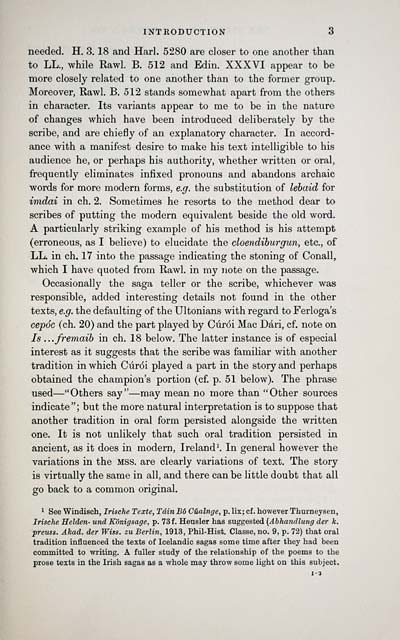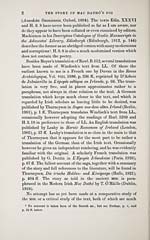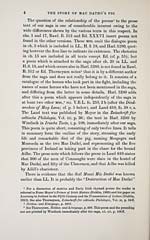Download files
Complete book:
Individual page:
Thumbnail gallery: Grid view | List view

INTRODUCTION 3
needed. H. 3. 18 and Harl. 5280 are closer to one another than
to LL., while Rawl. B. 512 and Edin. XXXVI appear to be
more closely related to one another than to the former group.
Moreover, Rawl. B. 512 stands somewhat apart from the others
in character. Its variants appear to me to be in the nature
of changes which have been introduced deliberately by the
scribe, and are chiefly of an explanatory character. In accord-
ance with a manifest desire to make his text intelligible to his
audience he, or perhaps his authority, whether written or oral,
frequently eliminates infixed pronouns and abandons archaic
words for more modern forms, e.g. the substitution of lebaid for
imdai in ch. 2. Sometimes he resorts to the method dear to
scribes of putting the modern equivalent beside the old word.
A particularly striking example of his method is his attempt
(erroneous, as I believe) to elucidate the cloendiburgun, etc., of
LL. in ch. 17 into the passage indicating the stoning of Conall,
which I have quoted from Rawl. in my note on the passage.
Occasionally the saga teller or the scribe, whichever was
responsible, added interesting details not found in the other
texts, e.g. the defaulting of the Ultonians with regard to Ferloga's
cepóc (ch. 20) and the part played by Cúrói Mac Dári, cf. note on
Is ...fremaib in ch. 18 below. The latter instance is of especial
interest as it suggests that the scribe was familiar with another
tradition in which Cúrói played a part in the story and perhaps
obtained the champion's portion (cf. p. 51 below). The phrase
used — "Others say" — may mean no more than "Other sources
indicate"; but the more natural interpretation is to suppose that
another tradition in oral form persisted alongside the written
one. It is not unlikely that such oral tradition persisted in
ancient, as it does in modern, Ireland 1 . In general however the
variations in the MSS. are clearly variations of text. The story
is virtually the same in all, and there can be little doubt that all
go back to a common original.
1 See Windisch, Irische Texte, Táin Bó Cúalnge, p. lix; cf. however Thurneysen,
Irische Helden- und Konigsage, p. 73 f. Heusler has suggested (Abhandlung der k.
preuss. Akad. der Wiss. zu Berlin, 1913, Phil-Hist. Classe, no. 9, p. 72) that oral
tradition influenced the texts of Icelandic sagas some time after they had been
committed to writing. A fuller study of the relationship of the poems to the
prose texts in the Irish sagas as a whole may throw some light on this subject.
needed. H. 3. 18 and Harl. 5280 are closer to one another than
to LL., while Rawl. B. 512 and Edin. XXXVI appear to be
more closely related to one another than to the former group.
Moreover, Rawl. B. 512 stands somewhat apart from the others
in character. Its variants appear to me to be in the nature
of changes which have been introduced deliberately by the
scribe, and are chiefly of an explanatory character. In accord-
ance with a manifest desire to make his text intelligible to his
audience he, or perhaps his authority, whether written or oral,
frequently eliminates infixed pronouns and abandons archaic
words for more modern forms, e.g. the substitution of lebaid for
imdai in ch. 2. Sometimes he resorts to the method dear to
scribes of putting the modern equivalent beside the old word.
A particularly striking example of his method is his attempt
(erroneous, as I believe) to elucidate the cloendiburgun, etc., of
LL. in ch. 17 into the passage indicating the stoning of Conall,
which I have quoted from Rawl. in my note on the passage.
Occasionally the saga teller or the scribe, whichever was
responsible, added interesting details not found in the other
texts, e.g. the defaulting of the Ultonians with regard to Ferloga's
cepóc (ch. 20) and the part played by Cúrói Mac Dári, cf. note on
Is ...fremaib in ch. 18 below. The latter instance is of especial
interest as it suggests that the scribe was familiar with another
tradition in which Cúrói played a part in the story and perhaps
obtained the champion's portion (cf. p. 51 below). The phrase
used — "Others say" — may mean no more than "Other sources
indicate"; but the more natural interpretation is to suppose that
another tradition in oral form persisted alongside the written
one. It is not unlikely that such oral tradition persisted in
ancient, as it does in modern, Ireland 1 . In general however the
variations in the MSS. are clearly variations of text. The story
is virtually the same in all, and there can be little doubt that all
go back to a common original.
1 See Windisch, Irische Texte, Táin Bó Cúalnge, p. lix; cf. however Thurneysen,
Irische Helden- und Konigsage, p. 73 f. Heusler has suggested (Abhandlung der k.
preuss. Akad. der Wiss. zu Berlin, 1913, Phil-Hist. Classe, no. 9, p. 72) that oral
tradition influenced the texts of Icelandic sagas some time after they had been
committed to writing. A fuller study of the relationship of the poems to the
prose texts in the Irish sagas as a whole may throw some light on this subject.
Set display mode to: Large image | Transcription
Images and transcriptions on this page, including medium image downloads, may be used under the Creative Commons Attribution 4.0 International Licence unless otherwise stated. ![]()
| Early Gaelic Book Collections > Matheson Collection > Early Irish reader > (15) |
|---|
| Permanent URL | https://digital.nls.uk/76535033 |
|---|
| Description | Items from a collection of 170 volumes relating to Gaelic matters. Mainly philological works in the Celtic and some non-Celtic languages. Some books extensively annotated by Angus Matheson, the first Professor of Celtic at Glasgow University. |
|---|
| Description | Selected items from five 'Special and Named Printed Collections'. Includes books in Gaelic and other Celtic languages, works about the Gaels, their languages, literature, culture and history. |
|---|

